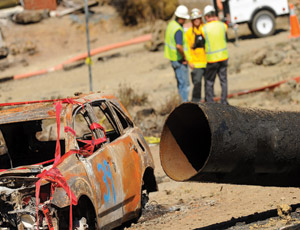The natural-gas pipeline explosion that killed at least four people and destroyed 38 homes on Sept. 9 in San Bruno, Calif., has prompted the California Public Utilities Commission to come down hard on the pipeline owner, San Francisco-based PG&E.

In a letter to PG&E President Christopher Johns, the agency directed the utility to take a number of remedial measures: conduct an integrity assessment of all gas facilities near the blast site; perform an “accelerated” leak survey of all transmission lines at heavily populated locations in PG&E’s central and northern California service territory; prepare a plan to inspect the utility’s entire 6,438-mile natural- gas transmission pipeline system; and preserve all records related to the maintenance or modifications performed by PG&E and its contractors over the past 10 years on the San Bruno line.
PUC also wants PG&E to provide actual versus authorized levels of spending on pipeline safety and pipeline replacements from 2005 to the present. PG&E, which has committed $100 million to a no-strings-attached “Rebuild San Bruno Fund” for now homeless residents, says it will comply fully with PUC and that it routinely conducts leak surveys of all its lines. The utility says that, two days after the Sept. 9 incident, it began surveying the three transmission lines that feed the San Francisco Peninsula and, as a safety measure, reduced pressure by 10%.
Meanwhile, federal investigators from the National Transportation Safety Board were looking into why the gas line ruptured and exploded, sending a 28-ft segment of the 30-in.-wide pipe onto a street 100 ft away while creating a crater 167 ft long, 26 ft wide and 40 ft deep.
The NTSB is shipping that segment of pipe back to Washington, D.C., for inspection. The board says the entire probe into the incident will take up to a year to complete.
Corrosion and moisture are likely culprits in the disaster, speculates Mo Ehsani, a former professor of engineering at the University of Arizona in Tucson and owner of QuakeWrap Inc., a manufacturer of products for the repair and retrofit of structures, including pipelines. The pipe was 54 years old, basically the life expectancy for steel pipe, he adds.



Post a comment to this article
Report Abusive Comment